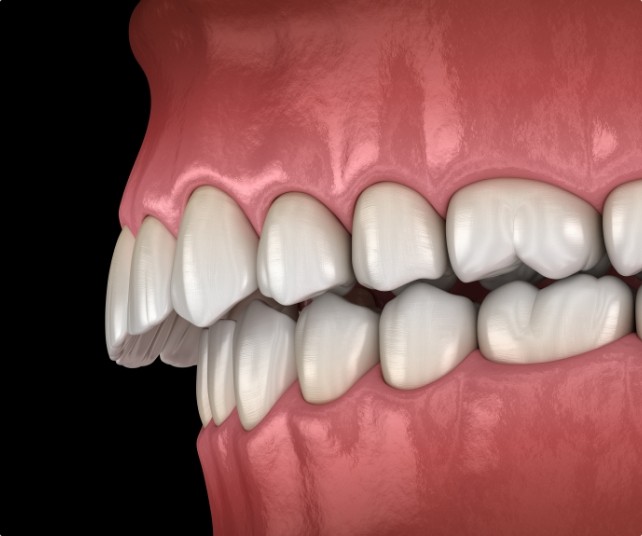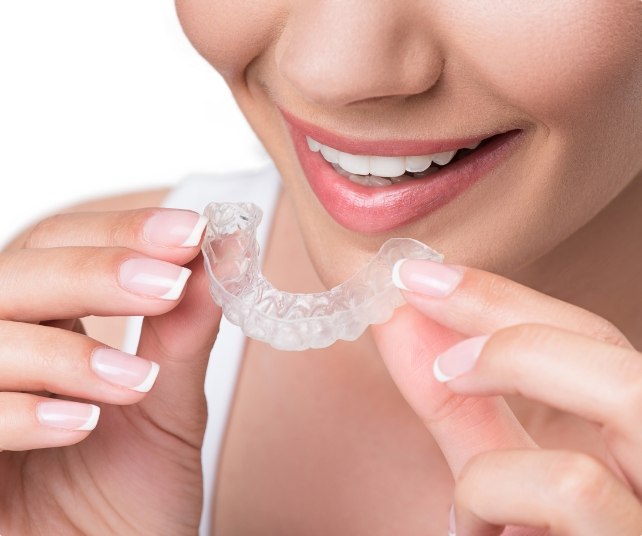TMJ Treatment – Little Ferry, NJ
Personalized Solutions for Chronic Jaw Pain
If you’ve been struggling with frequent jaw pain, there might be a problem with your temporomandibular joints, or TMJ. These tiny joints are located just in front of your ears and allow you to open and close your mouth as well as move your jaw from side to side. Because the TMJ are so delicate, any dysfunction could result in severe pain. At Erin Dental, we offer personalized treatment for TMJ disorder (TMD), and you can get the relief you need by calling our dental office to schedule an appointment for TMJ treatment in Little Ferry, NJ.
Why Choose Erin Dental for TMJ Treatment?
- Comfortable, Custom-Fit Occlusal Splints
- Dental Insurance Welcome & Maximized
- Friendly Dentist Who Speaks English & Spanish
Diagnosis & Treatment

In addition to jaw pain, TMJ disorder may present several other symptoms, including:
- Difficulty opening and closing the mouth.
- Clicking or popping sounds when moving the jaw.
- Frequent headaches or migraines.
- Pain in the ears, neck, and/or shoulders.
TMD has various possible causes, from bruxism (chronic teeth grinding), stress, arthritis, or injury to the jaw or face. Dr. Peters will perform a detailed exam to identify the cause of your jaw pain, and if TMD is to blame, then she can recommend a treatment plan.
Equilibration / Occlusal Adjustments

Sometimes, your jaw joints might be strained by a misaligned bite. When a dental restoration or tooth isn’t even with the arch as a whole, it can throw off the balance of your biting force, placing undue pressure on your jaw joints. With equilibration / occlusal adjustments, Dr. Peters can precisely file down the specific areas that are causing the problem, bringing your overall bite into the proper alignment.
Occlusal Splints

Perhaps the simplest way to treat TMD is with a mouthguard-like device called an occlusal splint. Made from durable yet comfortable plastic, the splint fits over your teeth to create a barrier between the upper and lower arches. It also gently repositions your jaws to relieve the stress on your TMJs. Often, patients are able to enjoy permanent relief from their TMD symptoms after mere months or even weeks of wearing their occlusal splints to bed every night.
TMJ Treatment FAQs
Can TMJ Be Cured Permanently?
Discomfort associated with TMJ disorder can alleviate over time, but if symptoms impact daily life, professional treatment is recommended. Occlusal splints and adjustments target jaw tension and misalignment for lasting relief.
While TMJ disorder can be distressing, it often resolves gradually with lifestyle adjustments and home remedies. However, if symptoms persist or worsen, seeking professional assistance becomes crucial.
Treatment options like occlusal splints, also known as bite guards, are custom-made devices worn over the teeth to realign the jaw and alleviate tension. Equilibration, another approach, involves adjusting the biting surfaces of the teeth to improve the overall balance of the bite. These methods aim not only to alleviate symptoms temporarily but to address the underlying causes of TMJ disorder for long-term relief.
Is TMJ Treatment Safe?
TMJ treatment, when administered by a qualified professional, is generally safe. The National Institutes of Health suggest conservative approaches to minimize risks. Procedures like occlusal splints and equilibration are proven safe for TMJ.
Ensuring the safety of TMJ treatment primarily lies in the hands of a skilled practitioner. While TMJ disorder itself isn't life-threatening, the discomfort and limitations it imposes on daily life can be significant. Therefore, seeking treatment from a qualified dentist or specialist trained in TMJ therapy is essential.
Conservative methods, such as occlusal splints and equilibration, are preferred for their minimal invasiveness and reduced risk of complications. These approaches aim to realign the jaw and improve its function without resorting to surgery, which carries inherent risks. By opting for safe and effective treatment modalities, individuals can manage TMJ disorder and regain control over their oral health and overall well-being.
Can TMJ Be Treated Without Surgery?
Absolutely. Conservative methods are often preferred for TMJ treatment. Surgery, a last resort due to its permanence and risks, can usually be avoided. Occlusal splints, equilibration, and other non-invasive options offer effective relief.
For individuals suffering from TMJ disorder, the prospect of surgery can be daunting. However, the good news is that surgery is rarely necessary to alleviate TMJ symptoms. Non-invasive treatments, including occlusal splints and equilibration, offer effective alternatives that address the root causes of TMJ disorder without the need for surgical intervention.
Occlusal splints, for example, are custom-made oral appliances that help realign the jaw and relieve pressure on the temporomandibular joint. Equilibration, on the other hand, involves adjusting the biting surfaces of the teeth to ensure proper alignment and function. Both approaches are safe, minimally invasive, and can provide significant relief from TMJ symptoms.
Does Occlusal Adjustment for TMJ Hurt?
Occlusal adjustments are meticulously carried out to ensure comfort. They involve precise filing or adding to teeth or restorations. While soreness post-treatment is possible, it's typically mild and temporary, with minimal need for anesthesia.
The thought of undergoing a dental procedure can be intimidating, especially for individuals experiencing TMJ disorder. However, occlusal adjustment, also known as equilibration, is a relatively painless procedure that can provide significant relief from TMJ symptoms.
During occlusal adjustment, your dentist will carefully assess your bite and make precise alterations to ensure proper alignment and function. This may involve filing down or reshaping the biting surfaces of the teeth or adding composite resin to build up worn or damaged areas.
While you may experience some mild soreness or discomfort following the procedure, this can usually be managed with over-the-counter pain medication and should subside within a few days. In most cases, local anesthesia is not necessary for occlusal adjustment, as the procedure is minimally invasive and generally well-tolerated by patients.
